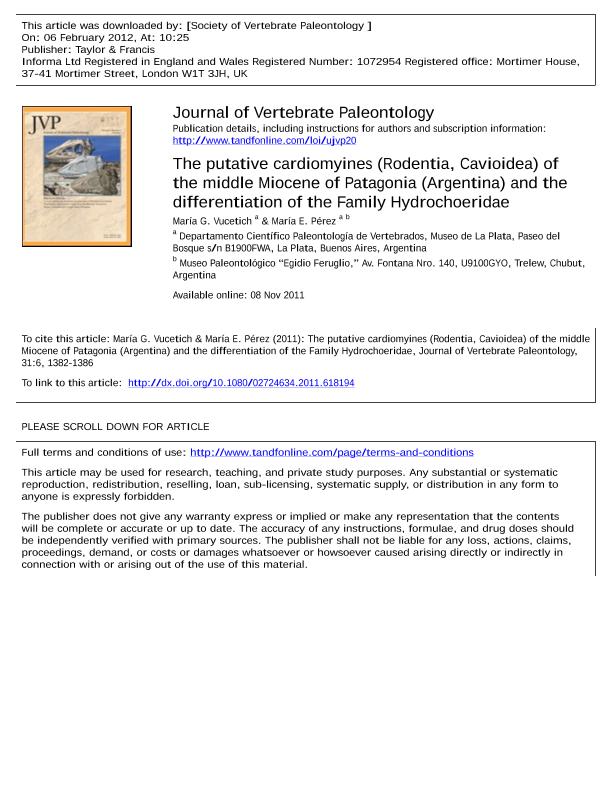Mostrar el registro sencillo del ítem
dc.contributor.author
Vucetich, María Guiomar

dc.contributor.author
Pérez, María Encarnación

dc.date.available
2023-04-17T18:16:43Z
dc.date.issued
2011-11
dc.identifier.citation
Vucetich, María Guiomar; Pérez, María Encarnación; The putative cardiomyines (Rodentia, Cavioidea) of the middle Miocene of Patagonia (Argentina) and the differentiation of the Family Hydrochoeridae; Society of Vertebrate Paleontology; Journal of Vertebrate Paleontology; 31; 6; 11-2011; 1382-1386
dc.identifier.issn
0272-4634
dc.identifier.uri
http://hdl.handle.net/11336/194244
dc.description.abstract
The crown group of Cavioidea sensu stricto (comprises Caviidae (Caviinae [Cuyes] and Dolichotinae [Maras]) and Hydrochoeridae. The latter encompasses the gigantic semiaquatic Hydrochoerinae (Capybaras), the small and rock dweller Kerodon (Mocos), and the extinct Cardiomyinae, a group of large rodents that share with the hydrochoerines ever-growing double-heartshaped cheek teeth with accessory fissures on lingual (lowers) and labial (uppers) walls, enlarged M3 and p4, and a broad palate. In spite of these similarities, cardiomyines were classically classified as Caviidae. The crown group of Cavioidea s.s. is first recorded in the middle Miocene of Colombia with Prodolichotis pridiana. Additionally, Kraglievich, based on two isolated lower molars, described two species from the late middle Miocene of Patagonia that tentatively assigned to the cardiomyine Cardiomys (Cardiomys? huemulensis and C.? andinus). But it is in the early late Miocene when the fossil record shows the Cavioidea s.s. fully differentiated. The most important turnover in the history of caviomorph rodents occurred precisely during the middle Miocene, especially after the Colloncuran age. It involved the extinction of most of the ancient genera as well as the appearance of several new clades usually classified as ?families? and ?subfamilies?. For Cavioidea in particular, this turnover involved the extinction of ?eocardiids? as well as other primitive cavioids on the one hand, and the differentiation of the members of the crown group (Hydrochoerinae, Cardiomyinae, Dolichotinae, and Caviinae) on the other. In this paper we restudy the middle Miocene teeth referred to Cardiomys? by Kraglievich and reanalyze their affinities with other cavioids, their bearing in the comprehension of the evolutionary events occurred during the middle Miocene in Patagonia, as well as the origin and diversification of modern cavioids. We also restudy the holotype of the Chasicoan Procardiomys martinoi, in order to elucidate some doubts on its anatomy and correct definition expressed by Pascual himself, and to understand its bearing in the cardiomyine evolution.
dc.format
application/pdf
dc.language.iso
eng
dc.publisher
Society of Vertebrate Paleontology

dc.rights
info:eu-repo/semantics/openAccess
dc.rights.uri
https://creativecommons.org/licenses/by-nc-sa/2.5/ar/
dc.subject
RODENTIA
dc.subject
CARDYOMINES
dc.subject
PATAGONIA
dc.subject
MIDDLE MIOCENE
dc.subject.classification
Otras Ciencias Biológicas

dc.subject.classification
Ciencias Biológicas

dc.subject.classification
CIENCIAS NATURALES Y EXACTAS

dc.title
The putative cardiomyines (Rodentia, Cavioidea) of the middle Miocene of Patagonia (Argentina) and the differentiation of the Family Hydrochoeridae
dc.type
info:eu-repo/semantics/article
dc.type
info:ar-repo/semantics/artículo
dc.type
info:eu-repo/semantics/publishedVersion
dc.date.updated
2023-04-14T15:46:48Z
dc.journal.volume
31
dc.journal.number
6
dc.journal.pagination
1382-1386
dc.journal.pais
Estados Unidos

dc.description.fil
Fil: Vucetich, María Guiomar. Universidad Nacional de La Plata. Facultad de Ciencias Naturales y Museo. Departamento Científico de Paleontología de Vertebrados; Argentina. Consejo Nacional de Investigaciones Científicas y Técnicas; Argentina
dc.description.fil
Fil: Pérez, María Encarnación. Universidad Nacional de La Plata. Facultad de Ciencias Naturales y Museo. Departamento Científico de Paleontología de Vertebrados; Argentina. Consejo Nacional de Investigaciones Científicas y Técnicas; Argentina. Museo Paleontológico Egidio Feruglio; Argentina
dc.journal.title
Journal of Vertebrate Paleontology

dc.relation.alternativeid
info:eu-repo/semantics/altIdentifier/url/https://www.tandfonline.com/doi/abs/10.1080/02724634.2011.618194
dc.relation.alternativeid
info:eu-repo/semantics/altIdentifier/doi/http://dx.doi.org/10.1080/02724634.2011.618194
Archivos asociados
